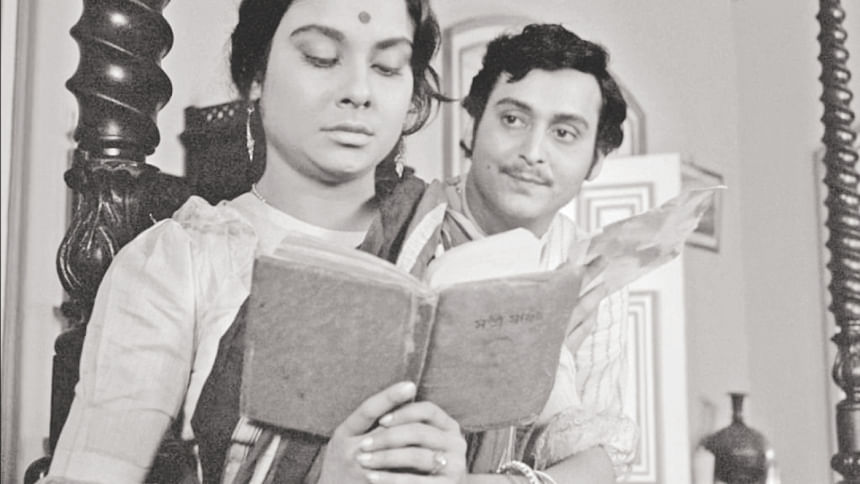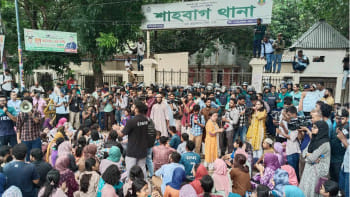Satyajit's Rabindranath connection

On a wintry day at Santiniketan in 1931, one Suprova Debi brought her 10-year old son to be graced by the blessing of Rabindranath Tagore. As the child handed the bard a notebook for an autograph, Rabindranath did not sign and return it immediately, but took it home with him.
The next day, the boy went to Tagore's residence, Uttarayan, to get back his autograph book, and in there was inscribed a small poem along with his signature, the famous “Dekha Hoy Nai Chokkhu Meliya, Ghor Hote Shudhu Dui Pa Pheliya, Ekti Dhan'er Shish er Opor Ekti Shishir Bindu”.
Maybe it was just the kobiguru's affection; or maybe he had foreseen the literary and creative icon this child would grow up to be. Six years later, that child, Manik, came back to Santiniketan to the Visva Bharati University, and until Rabindranath's demise in 1941, grew up under his tutelage.
And Manik, who would grow up to be a powerful figure in world cinema as Satyajit Ray, carried on this connection all along his life. The multifaceted genius would turn 95 tomorrow (May 2), had he been alive.
Satyajit's grandfather Upendra Kishore Roy Chowdhury was friends with Rabindranath, and his father, the inimitable Sukumar Roy chose the right path for his son's creative development.
In 1960, the Indian government handed Satyajit the responsibility to make a documentary on Rabindranath, marking his birth centenary (1961). Of the very few moving pictures where Tagore can be seen, some are in that documentary, “Rabindranath Tagore”, shot by a young Satyajit at Santiniketan. Also in 1961, Satyajit's film “Teen Konya” was released, bringing to life three short stories of Rabindranath – “Postmaster”, “Monihara” and “Samapti”, with female characters at their centre.
Then in 1964, at the peak of his filmmaking career, Satyajit made “Charulata”, based on Rabindranath's long story “Noshto-neer”. The film is often referred to as Satyajit's most 'perfect' movie, and remains an all-time classic of Bangla cinema.
The intricate characters and dramatic turns of Rabindranath's storytelling came alive through Satyajit's lens and the acting prowess of the likes of Soumitra Chatterjee, Madhabi Mukherjee, Shailen Mukherjee and Shyamol Ghoshal. The film brought home the prestigious Silver Bear from the 1964 Berlin Film Festival and won the Best Film in India's National Film Awards that year.

In 1984, at the twilight of his filmmaking career, Satyajit made one last film based on a Tagore novel: “Ghare Baire”. It is said that he wrote this script even before making his first film, “Poth'er Pachali”. Tagore's portrayal of women touched a chord with Satyajit, and after “Teen Konya” and “Charulata” which both had women characters at the fore, “Ghare Baire” once again brought forward the dynamics of liberty and love for Bimala, played by Swatilekha Sengupta. The film screened in competition for the Palme d'Or at the 1984 Cannes, and won the Best Bangla Language Film at India's National Film Awards that year.
Nearly every filmmaker of note of that era – Tapan Sinha, Mrinal Sen, Purnendu Potree, Nitin Bose, Sudhendu Roy – made films based on Tagore's stories, and many found success with it, but none as much as Satyajit. Maybe it was his close association with the bard from an early age, maybe it was his upbringing in a literary family. Maybe it was just astrological: they do have their birthdays in the space of five days. Whatever the reason may be, the combination of these two stalwarts have left us with some beautiful creations on celluloid, and maybe we should not look for reasons so much as we should be grateful.

 For all latest news, follow The Daily Star's Google News channel.
For all latest news, follow The Daily Star's Google News channel. 



Comments